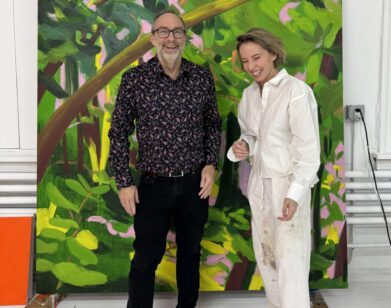Emily Sundblad

ABOVE: EMILY SUNDBLAD IN NEW YORK, JANUARY 2014. TOP: MIU MIU. STYLING: VANESSA CHOW. COSMETICS : CHANEL, INCLUDING SUBLIMAGE LA CREÌME. HAIR PRODUCTS: ORIBE, INCLUDING SMOOTH STYLE SERUM. HAIR: ANDRE GUNN FOR ORIBE/THE WALL GROUP. MAKEUP: KRISTI MATAMOROS FOR CHANEL/KATE RYAN INC. SPECIAL THANKS: TENTON STUDIO.
For the Whitney Biennial, co-curator Michelle Grabner asked painter, gallerist, and musician Emily Sundblad to contribute a video. Grabner considered the medium a way to allow the multidisciplined, curatorial-minded artist to be “responsible for her own narrative construction.” Born in Sweden in 1977, Sundblad has had a hand in the Whitney Biennial once before. In 2006, she created a series of awnings with John Kelsey and Jutta Koether. Together the artists (and others) function as Reena Spaulings, an art collective and gallery located in Chinatown that exhibits one of the most consistently unpredictable and satisfying programs in New York. “I still consider the gallery the most important work I do in the sense of society and history,” Sundblad says. As an artist in her own right, Sundblad is known for her vibrant paintings—especially of flowers, which she describes as “a good empty subject.” Her approach is that of a Sunday painter—humble and modest, using oil, pastel, gouache, and watercolor in “a simple impulse to record everyday life.” As a musician, Sundblad sings with a dulcet, violin-like tone and works in traditions she considers populist: country, punk, torch songs, and British folk music. Often, the songs are covers of well-known classics (she does a sweetly lugubrious version of “Love Hurts”) and are performed in galleries and museums.
Sundblad’s video for the Biennial isn’t going to undermine the sense of the artist’s presence, which informs so much of her other projects. As of now, she’s planning a streaming broadcast of a musical performance to be included in the Whitney galleries. This transmitted form, she says, “frees up performing so that it’s both public and private at the same time. It’s why people go crazy on Instagram and Vine, because there’s the sense of a private freedom of expression, even though it’s a public act.” Her previous foray into streaming live video was for a show in August 2013 at Artists Space. In the middle of the night, from her mother’s home in rural Sweden, Sundblad Skyped herself playing hymnals on the piano as two collaborators across the ocean performed with her at the gallery in real time. “It made me realize that, through social media, there’s a potential to access a spirituality in performance,” she says, “which might be harder to do in front of an audience or in a gallery.” As refreshingly optimistic as her view of technology is, she also speaks longingly of the time before screens, when people drew pictures and played instruments as a part of daily life. That, for her, remains one of the primary pleasures of art. “Daily drawing like that—it’s still a good tool,” she says. “It’s good for human beings.”
For more from the 2014 Whitney Biennial, click here.






